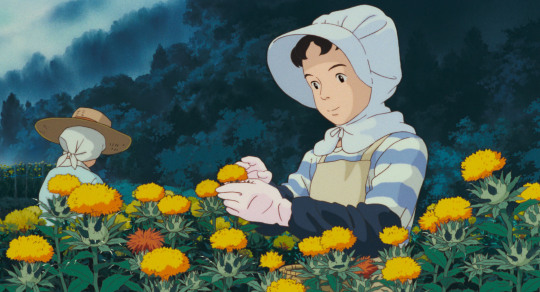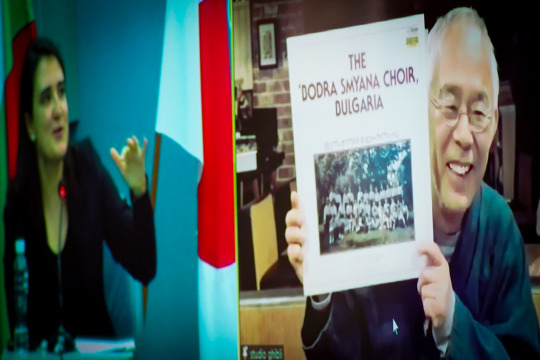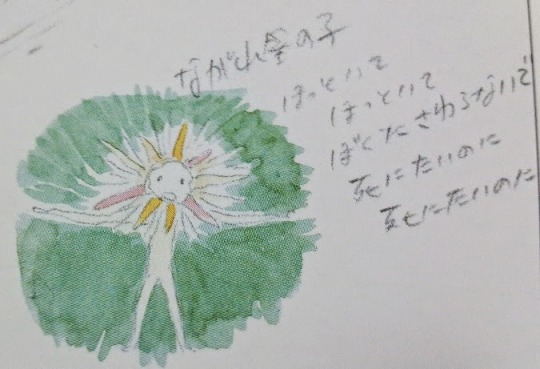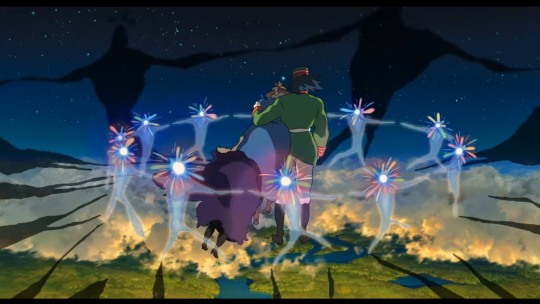#bulgarian music in ghibli films
Text
Bulgarian Music in Studio Ghibli films
”Myth has it that Orpheus was born in what is now Bulgaria. It seemed to be fact, not myth, that his daughters are still singing there”
These words were written by the New York Times in the remote 1963 — the year in which the largest Bulgarian folk ensemble crossed the Iron Curtain to conquer an entire continent with its cosmic art.
The 1975 release of Le Mystère des Voix Bulgares, a compilation album of modern arrangements of Bulgarian folk songs, further popularized Bulgarian music, and in 1977, a vinyl record featuring the folk song “Izlel ye Delyo Haydutin” (Eng: Come out rebel Delyo) began its journey aboard the Voyager 1 and Voyager 2 spacecrafts.
From this point on popularity from the West spread to the East, and Bulgarian folk music made it to the entertainment industry, including legendary Japanese anime films, like the cult cyberpunk “Ghost in the Shell” or the heartwarming Studio Ghibli features.
In this short article I write about two occasions of Bulgarian music playing in Studio Ghibli’s films.
The record that inspired the creation of “Only Yesterday”
“Only Yesterday” is a 1991 Japanese animated drama film written and directed by Isao Takahata, based on the 1982 manga of the same title by Hotaru Okamoto and Yuko Tone. Set in rural Japan, the film draws parallels with the peasant lifestyle present in Eastern Europe.
The original work is a compilation of short stories about 11-year-old Taeko’s daily life in 1966. Director Takahata had a hard time making it into a movie since the manga, told in the form of a memoir, has no plot to hold a feature. Together with producer Toshio Suzuki, they came up with the solution of bringing the narrator of the story, adult Taeko, into the movie. But there is a curious anecdote about how this idea came to mind.

Taeko picks safflower as the Bulgarian song “Malka moma dvori mete” plays in the background. © Studio Ghibli
In a 2021 interview with students from Sofia University St. Kliment Ohridski, producer Suzuki recounts how a record of Bulgarian songs performed by the children choir “Bodra Smyana”, introduced to him by director Takahata, inspired the creation of the movie. Moved by the cosmic voices of the children, they decided to make “Only Yesterday” a musical. He also recalls what a tiring process it was to acquire the rights to the music, but if you’ve seen the movie, I am sure you will agree that it was worth it; the haunting, beautiful songs with the pastoral images of farmers picking flowers contribute to one of the greatest scenes created in cinema.

Producer Suzuki showing the record that inspired the creation of ”Only Yesterday”. Source: Studio Ghibli’s Twitter
In “Only Yesterday”, we can hear two songs from the album Bulgarian Polyphony I by Philip Koutev Ensemble. The upbeat “Dilmano Dilbero” [Eng. beautiful Dilmana] sets a happy mood as the protagonist gets changed and ready to go on the field. As the scene shifts and Taeko starts narrating a sad story about the girls in the past picking safflower with their bare hands, the song and mood shift as well.
While the first song has a fast rhythm, with lyrics about pepper planting that can also be interpreted figuratively, the second one, “Malka Moma Dvori Mete” [Eng., a little girl sweeps the yard], is a ballad about a young girl who is forced into marriage but has never known true love.
Both compositions sing about life-cycle events like marriage and the regular coming of the harvests, with lyrics perfectly fitting the setting and plot of the movie, which makes me wonder if the filmmakers chose them by chance or if they had someone translate the words.
Bulgarian Cosmic Voices Enchanting Howl
“Howl’s Moving Castle” is a 2004 Japanese animated fantasy film written and directed by Hayao Miyazaki, loosely based on the 1986 novel of the same name by British author Diana Wynne Jones. Set in a fictional kingdom the movie draws inspiration from various places in Europe. One of them being Bulgaria.
The story focuses on a young girl, named Sophie, magically transformed into an old woman, and a self-confident but emotionally unstable young wizard, Howl, living in a magical moving castle.

A sketch of a Star Child. Source: The Art of Howl’s Moving Castle
If you’ve seen the movie, you surely remember the scene when Madame Suliman ambushes Howl and tries to strip him of his magic powers. Star Children encircle him and his companions; their shadows grow big, dark and intimidating. They start dancing and chanting unintelligible magic words and are almost successful in their devilish act.
This scene, together with the music played in the background, have been a favourite of many fans of the film. Some even recount it giving them nightmares when they were children.

Star Children encircle Howl in an attempt to strip him of his magic powers. © Studio Ghibli
It turns out, however, that these aren’t any incantations, but the lyrics of a folk song. In Bulgarian. And a love song! Contrary to popular belief, the lyrics have nothing to do with magic and are actually about a boy taking his sweetheart, Dona, to the market to buy her new clothes. The excerpt used in the movie is very short and a bit altered from the original, but the words used go like this: Trendafilcheto, kalafercheto, Done mamino, translated as “the rose, the costmary, my darling Dona”.
I am planing a follow up article where I will post the translated lyrics together with a brief explanation on how they are related to the movies.
If you want to comment on or add something, I would love to hear!
Source
#studio ghibli#only yesterday#howls moving castle#Le Mystère des Voix Bulgares#bulgarian folklore#bulgaria#toshio suzuki#hayao miyazaki#isao takahata#bulgarian music in ghibli films#the boy and the heron#スタジオジブリ#ブルガリア#おもひでぽろぽろ#ハウルの動く城#宮崎駿#高畑勲#鈴木敏夫#bulgarian music
584 notes
·
View notes
Video
youtube
Pop Music in Ghibli
If you mention Ghibli and soundtracks in the same breath to most people, the first thing they will likely think of is Joe Hisaishi-senpai’s prodigious and immaculate compositions, BUT it occurred to me recently that there’s actually a great amount of pop music showing up in a handful of some of my very favorite Ghibli films. They’re more rare compared to the instrumental tracks, sure, but in that way it might be even be more impactful-- especially for plebeians without an ear for vocal-less music-- when they do show up. Click through as I explore pop music in 5 Ghibli classics.
#1- The Wind Rises: ‘ "Hikōki-gumo" (ひこうき雲) by Yumi Matsutoya
Okay so hearing this song on a recent viewing of this film was the whole impetus for writing this. By hugely influential and popular song-writer Yumi Matsutoya, this closing-credits track drops just in time for a full fatality against the viewers’ emotional fortitude- if it remains in tact at all by that point. Between the bittersweet lyrics-- which corresponds beautifully with a plot point from the end of the film-- a righteous hammond organ part and this heart-breaking melody, it all just becomes a bit too much, in a great way.
Mrs. Matsutoya here is outright indecent towards our emotions here. And I love it. In addition to that, the track counts as only one of a few instances of a pop song in a Ghibli joint serving as the closing track. So uh yeah, go down a rabbit hole of Matsutoya’s music if you wanna explore the wonderful world of vintage J-pop/city pop etc., and you will not be disappoint. Also, this isn’t even the first time one of her songs was used... her debut in Ghibli occured 2 decades earlier in....
#2- Kiki’s Delivery Service: ‘I’m Gonna Fly”- Sydney Forester
Okay, so this is not another Matsutoya song. But in the original Disney release of Kiki, this song stood in for what was in the Japanese release a rather different, rockabilly-pop song from one of Matsutoya’s early albums ‘Rouge no Dengon‘, and this has since been corrected on subsequent releases. Tonally they are pretty different, but they both share a level of charm. This English replacement is way cornier though, but I imagine whichever one you grow up with will be the superior and preferable dose of nostalgia. I’m tainted by living with the original 90s English version for so long, that I get really thrown off in the first 20 minutes if, mid-maiden voyage, Kiki turns on her radio to Matsutoya instead of this funny little stand-in.
youtube
Speaking of Kiki’s radio, this is one of only TWO instances I’m aware of in which the pop song is diegetic within the film-- meaning it actually comes from a source within the actual world of the movie-- at least sort of (it’s that kinda pseudo-diegesis where the volume of the song makes it clear that it can’t actually be coming from her little radio). This song just really has a kind of saccharine horse-girl charm which I love and I feel like it matches the movie’s atmosphere pretty well despite being modern sounding, whereas Kiki’s world seems to be vaguely set in a version of the.... 50′s where dirigibles never went away? Never really thought about it actually.
But yeah, these weird contract-based one-off recording artist concoctions are always kinda fun. They remind me of weird tracks from the Detective Conan opening themes where you just wonder about how and why they come about. Ultimately though, Disney probably made a good choice. The song occurs early enough in the film that it might do some work towards dissuading any reservations younger viewer-- or their parents-- might have after wading into such a then-exotic animated film such as this. It gently reassures one that despite appearances, this film CAN be a movie for English-speaking Americans. Plus I mean this lady’s voice actually rocks. I feel like it helped sell the movie to my older Jewel-listening sisters when we were kids and for that I’m grateful~
#3- Only Yesterday: “Omoide No Nagisa”- The Wild Ones (and much much more)
Okay so Only Yesterday is stuffed to the brim with tons of pop music and other cultural ephemera, far too much for me to parse through now (maybe deserving of its own deep-dive post) but I’ll focus on one that shows up early in the movie.
youtube
(This isn’t full track, for some reason the only full version on youtube will not embed: https://www.youtube.com/watch?v=MRlKvOiXgjo
This track plays during one of the early memoir-esque narration-heavy flashback scenes. It’s before we are fully thrust into those more washed-out, impressionistic coming-of-age sequences, and are being lead gently into that world by way of recollection from the now adult protagonist. She is remembering the craze in 1966 around “group-sounds”, a genre in Japan that was clearly partly indebted to the British Invasion happening on the other side of the world.
I like the song a lot because I can hear the Beatles, Kinks and Monkeys etc., but it has it’s own really unique flair on top of that influence. I hear smokey curry and coffee shops. Fuzzy bunny-eared television signals. I think of young fresh-faced Japanese Boomers experiencing a newly technicolor world of pop-culture. The echo on the mic pick-ups whirs in my mind pulling me back toward a “simpler time”.
The appearance of this song early on is a tip-off to the unfurling of a particularly globally-minded and varied soundtrack in this film which continues to surprise throughout the runtime-- it is my second favorite Ghibli soundtrack after ‘Totoro’ by far and that usually has to do with the incredible Bulgarian choir music that appears, but stuff like this Wild Ones track is just great too. Whether the male-lead/love-interest is playing that Bulgarian “peasant music” via his Toyota’s cassette player or we are getting a history lesson in early J-pop/rock, it’s all particularly tasty. There’s even a couple appearances from music from Japanese children’s television.
A lot of the referencing is nigh impossible for this westerner to parse, but all of it--save for one track-- is pretty ace. That one let-down for me is yet another pop song in the form of the ending credit-sequence track, a Japanese cover of ‘The Rose’. I think Bette Midler is just not a tasty association for an American of my ilk and so even if the rendition is tasteful, and the ending scene is beautiful, it remains the only time I’m let down sonically in the movie.
Before I move on, it’s worth mentioning that the movie itself may be named after an American film OR a song by the Carpenters. I can’t be sure, but I kinda wish they actually used this Carpenters track to close the film instead of ‘The Rose’ but maybe it was a licensing issue. Anyhow. Perfect movie.
#4- Whisper of the Hear: “Take Me Home, Country Roads”- John Denver/Olivia Newton John/Various
youtube
Okay so the way this song factors into the movie is way different than anything else we’ve discussed so far. I’ll embed the Olivia Newton-John rendition that the film opens with as opposed to the Japanese version that plays in the ending, because uh, as cute as it is, the vocalist (who I think is just the main-character’s voice actress?) is pitchy as hell (maybe in a twee, intentional way?)
But so yeah, this song is a big part of an initial and reoccurring plot-point in the film which has the young protag. translating the American song into Japanese with her school friends. It’s a slightly illegible plot-point if you watch the English dub, but it basically comes across. According to Wiki, the producer of the film’s daughter actually supplied her lyrics which Mr. Hayao himself supplemented, which is just too cute. In the film, her version is called ‘Concrete Roads’ which has some nice thematic resonance with a lot of the angst that shows up in ‘Pom Poko’ regarding the suburban developments which sprawled out from Tokyo and other major Japanese cities throughout the 20th cent., encroaching on that same beautiful countryside that John Denver was initially sending up.
In a climactic scene, the protag. nervously but triumphantly sings the song along with her magic-boy boyfriend and his grampa’s grampa-friends, and uh yeah it’s cute as heck.
The film is based on a manga, and though I’m too lazy to research this much, I assume the manga was the first to introduce the concept of centering so much of the story around a relatively benign country-pop tune such as this. But I mean, the choral arrangement in the intro of Newton-John’s is kinda emotional as hell. Mountain-momma indeed.
#5- My Neighbor Totoro: Ending Theme- I don’t know...
youtube
Alright we’ll end with a sampling from the best of the best. I’m not gonna force too much “research” for this ‘cause like, I don’t know man, I just don’t wanna do anything that would remotely threaten to extinguish the magic. And I refuse to ever listen to the abomination that is the Disney re-dub. But I understand they re-recorded these tracks for that. Which, like, why? I’m also assuming the songs were pretty faithful translations of original Japanese tracks, because they’re just too good to have just been created for the western release. Like Hisaishi has to be behind those kalimbas and synth-lines. The lady’s voice basically sounds like my mom to me(?) and the dusty patina on her vocal-track alone kinda makes me wanna weep.
And I kinda hate when people just joylessly parrot internet meme terms, but this song is what I would be unable to not describe as a “bop”. I mean the drums alone rip.
This song has a sister-track in the form of an introductory credit-sequence song which accompanies a ridiculously cute visualizer, and they’re both just perfect matches for the joyful, innocent and exuberant nature of the film itself. Elsewhere on the OST, this is basically the last time that I’m aware of Hisaishi using synthesizers and it’s just glorious. Get this man on drum-machines and synths again! So uh yeah, I mean it’s all just great. What else could I say? Best soundtrack of all time period. Full stop. The end.
----------------------------------------------------------------------------------------
Ok that’s that. Keep in mind, there’s like a small hanful of Ghibli I still haven’t seen so there could be some major instance I’m missing but uh, maybe I’ll update if one day I find out there’s a straight up Utada Hikaru song in ‘Princess Kaguya’. Oh and uh yeah there’s this one in ‘When Marnie Was There’ by one Priscilla Ahn . It’s like a b-side of the Kiki song but not as good as that makes it sound like it’d be. But it’s horse-girl-core as hell. So uh yeah.
youtube
see ya space cowboy~
#ghibli#soundtrack#pop music#vocals#instrumentals#yumi mastutoya#omoide no nagisa#whisper of the heart#john denver#olivia newton-john#when marnie was there#country roads#kiki's deliver service#only yesterday#the carpenters#priscilla ahn
2 notes
·
View notes